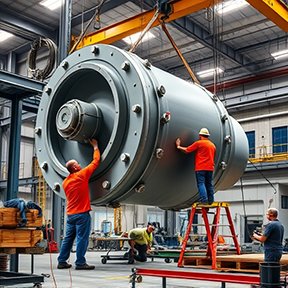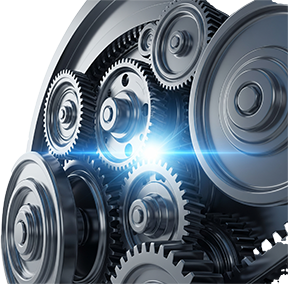Published: April 25, 2022 | Updated: October 06, 2025
Published: April 25, 2022 | Updated: October 06, 2025
Confronting the Hurdles: Essential Strategies for Overcoming Maintenance Obstacles
 Organizations across various industries encounter a consistent set of obstacles when it comes to maintaining their critical assets. These challenges can impede productivity, inflate operational costs, and ultimately affect the overall success of the enterprise. Recognizing and addressing these issues proactively marks a significant step toward achieving operational excellence. This exploration delves into essential strategies for overcoming maintenance obstacles and examines how a modern Computerized Maintenance Management System (CMMS) provides a pathway to resolution.
Organizations across various industries encounter a consistent set of obstacles when it comes to maintaining their critical assets. These challenges can impede productivity, inflate operational costs, and ultimately affect the overall success of the enterprise. Recognizing and addressing these issues proactively marks a significant step toward achieving operational excellence. This exploration delves into essential strategies for overcoming maintenance obstacles and examines how a modern Computerized Maintenance Management System (CMMS) provides a pathway to resolution.
The Eight Leading Maintenance Challenges
1. Excessive Unplanned Downtime
The sudden failure of equipment presents a significant disruption to operations. When machinery unexpectedly breaks down, entire production lines or crucial operational segments can grind to a halt while repairs occur. This unscheduled cessation of activity has a direct impact on productivity, potentially jeopardizing deadlines and necessitating difficult conversations with clients or stakeholders. The inability to anticipate these failures creates a volatile operational environment, driving up costs and hindering consistent output. Establishing a dependable system becomes crucial for mitigating these unforeseen interruptions.
Goal: Decrease Unplanned Downtime
2. Inaccurate Parts Inventory and Frequent Stockouts
Maintaining an optimal balance in parts inventory proves to be a delicate act. While excessive inventory ties up capital and utilizes valuable storage space, insufficient stock can lead to costly delays when critical repairs are needed. Consider a scenario where a machine malfunctions, but the necessary replacement part is unavailable. This absence halts the repair process, extending downtime and its associated costs. Conversely, an overabundance of seldom-used items occupies space that could better serve frequently required components. The efficient management of the stockroom, ensuring a steady flow of necessary items, distinguishes proactive maintenance operations.
Goal: Enhance Inventory Accuracy, Minimize Stockouts
3. Limited or Ineffective Maintenance Metrics
The health and performance of machinery often mirror that of the human body. Deviations from normal operating conditions, such as overheating or insufficient lubrication, can lead to decreased efficiency or complete failure. While some equipment features indicators to signal potential issues, the consistent monitoring of these vital signs often lacks rigor. Without diligent tracking of key performance indicators, the early detection of potential problems becomes challenging, allowing minor issues to escalate into major failures. A focused approach to performance management necessitates the regular observation and analysis of equipment metrics.
Goal: Refine Performance Management Practices
4. Insufficient Insight into Asset and Maintenance Performance
A lack of clarity regarding the duration and effectiveness of maintenance tasks can significantly impact operational efficiency. When seemingly straightforward jobs consume unexpectedly long periods or remain incomplete, it signals underlying issues. These delays can stem from various factors, including the unavailability of necessary parts or inefficiencies in locating them. Understanding the reasons behind these discrepancies allows for targeted improvements in work order management and resource allocation. Comprehensive visibility into work order completion provides a foundation for identifying and rectifying bottlenecks.
Goal: Achieve Improved and Transparent Work Order Completion Tracking
Discover how streamlined maintenance processes can elevate production. Learn more.
5. Inefficient Planning and Suboptimal Labor Productivity
Without clear guidelines and well-defined procedures, maintenance personnel may struggle to execute their tasks effectively. Ambiguity regarding what needs to be done, where, and how can lead to inconsistencies and reduced productivity. This lack of structured guidance not only affects the timely completion of maintenance activities but also contributes to increased operational costs. Implementing effective planning strategies and providing clear instructions are essential for maximizing the efficiency of the maintenance team and ensuring consistent outcomes.
Goal: Elevate Planning Efficiency and Labor Productivity
 6. Premature Equipment Failure and Shortened Lifecycles
6. Premature Equipment Failure and Shortened Lifecycles
The early replacement of equipment represents a significant and recurring expense for any organization. When assets fail to reach their expected lifespan, the frequency of capital expenditures increases, impacting the bottom line. Furthermore, the installation of new equipment can introduce periods of downtime, further disrupting operations. Extending the operational life of machinery through proactive maintenance practices yields substantial cost savings and ensures more consistent performance over time.
Goal: Prolong Equipment Lifespan
7. Extended Time from Maintenance Request to Repair Completion
The process for submitting and addressing maintenance requests can significantly influence the speed and effectiveness of repairs. Relying on informal methods such as verbal communication or scattered notes can lead to delays and oversights, particularly when dealing with urgent issues or safety hazards. Establishing a clear and efficient system for submitting, prioritizing, and tracking work requests accelerates the repair process and minimizes potential disruptions. Timely responses to maintenance needs are crucial for maintaining a safe and productive environment.
Goal: Expedite the Service Request Process
8. Equipment Operating Below Optimal Performance Levels
When machinery fails to perform at its designed capacity, overall operational efficiency suffers. This underperformance can manifest as slower production rates or reduced output quality. Identifying the underlying causes of this suboptimal functioning can be challenging without adequate monitoring and diagnostic tools. Addressing the previously mentioned challenges, such as insufficient maintenance or a lack of timely repairs, often contributes to bringing equipment back to peak operating condition. Ensuring assets function at their intended levels is vital for maximizing productivity and achieving operational targets.
Goal: Enhance System Performance
Empowering Maintenance Teams Through Training and Skill Development
In the pursuit of overcoming maintenance challenges, one critical yet often underemphasized area is the development of maintenance personnel. Even the most sophisticated tools and systems can fall short if the workforce lacks the skills and knowledge to utilize them effectively. Building a strong foundation through targeted training ensures that technicians and planners are equipped to respond efficiently to evolving maintenance demands
As equipment becomes more technologically advanced and maintenance practices continue to modernize, ongoing education is essential. Training programs that cover diagnostic techniques, safety procedures, and CMMS navigation can dramatically increase team performance. Furthermore, cross-training employees on multiple systems or machinery types enhances flexibility and minimizes downtime when specific personnel are unavailable.
A quality training strategy doesn't merely involve initial onboarding. It includes continuous development through workshops, certifications, mentorship, and real-time knowledge sharing. Empowered teams are more likely to identify early warning signs of equipment issues, follow standard operating procedures accurately, and contribute valuable feedback for process improvement.
Investing in workforce capability also positively influences morale and retention. Technicians who feel competent and valued are more engaged, which translates into greater care and attention in their work. Organizations that prioritize training cultivate a culture of accountability, innovation, and excellence—key elements in long-term maintenance success.
Ultimately, aligning maintenance training initiatives with broader operational goals creates a well-prepared workforce that serves as a frontline defense against equipment failure and inefficiency.
The Transformative Power of a CMMS
While spreadsheets may have served basic tracking purposes in the past, they often prove inadequate in addressing the complexities of modern maintenance challenges. A Computerized Maintenance Management System (CMMS) offers a comprehensive solution by integrating various maintenance functions into a centralized platform.
 Consider how a CMMS directly tackles the identified challenges:
Consider how a CMMS directly tackles the identified challenges:
- Reducing Downtime: By facilitating the scheduling and execution of preventive maintenance tasks–including inspections, lubrications, and parts replacements–a CMMS proactively minimizes the likelihood of unexpected equipment failures.
- Improving Inventory Management: A CMMS enables the meticulous tracking of parts inventory, including locations and quantities. Features such as automated reorder points ensure that necessary parts are always available, while insights into usage patterns prevent the accumulation of excess stock.
- Enhancing Performance Management: The system allows for the regular input and tracking of equipment readings, providing a historical record of performance and enabling the identification of trends or potential issues before they escalate.
- Providing Insight into Asset and Maintenance Performance: CMMS platforms offer the ability to track work order completion times, record notes on completed tasks, and identify potential bottlenecks or recurring issues. Checklists and clear instructions within work orders improve clarity and accountability.
- Boosting Planning and Productivity: A CMMS allows for the scheduling of maintenance tasks, assignment of work orders to specific personnel or teams, and the creation of detailed checklists, leading to improved organization and more efficient use of labor resources.
- Extending Equipment Life: By supporting consistent preventive maintenance schedules and tracking equipment depreciation, a CMMS helps organizations make informed decisions about equipment replacement and maximizes the lifespan of their assets.
- Accelerating Service Requests: Many CMMS solutions offer features that allow for the electronic submission of work requests, often via user-friendly interfaces or even direct links. This streamlines the request process and ensures timely attention to maintenance needs.
- Optimizing System Performance: The combined benefits of proactive maintenance, timely repairs, and performance monitoring facilitated by a CMMS contribute directly to ensuring that equipment operates at its peak efficiency.
The implementation of a CMMS represents a strategic investment in operational efficiency and long-term sustainability. It moves beyond reactive fixes to proactive management, fostering a culture of continuous improvement within the maintenance department.
The challenges inherent in equipment maintenance demand a sophisticated and integrated approach. Embracing a CMMS offers a significant advantage in navigating these complexities, leading to enhanced productivity, reduced costs, and a more resilient operational framework. The transition from outdated methods to a modern CMMS signifies a commitment to proactive management and a stronger, more efficient future. Explore the possibilities and consider taking the next step toward a more effective maintenance strategy by calling MAPCON at 800-922-4336.
FAQs
What are common maintenance challenges organizations face?
Organizations often encounter unplanned downtime, inaccurate inventory, poor performance tracking, inefficient planning, and shortened equipment lifecycles.
How can a CMMS reduce unplanned downtime?
A CMMS schedules and tracks preventive maintenance, helping avoid unexpected equipment failures and keeping operations running smoothly.
How does a CMMS improve inventory management?
Systems like MAPCON track parts locations, quantities, and reorder points, reducing stockouts and preventing excess inventory.
Can a CMMS enhance workforce productivity?
Yes, a CMMS helps assign work orders, create crews, manage tools, and provide checklists, improving efficiency and task completion.
Why is maintenance training important for overcoming obstacles?
Ongoing training ensures technicians can use CMMS tools effectively, identify early issues, and follow procedures consistently.
How does a CMMS optimize overall system performance?
By integrating preventive maintenance, performance tracking, work order management, and service request handling, a CMMS ensures equipment operates at peak efficiency.
MAPCON CMMS software empowers you to plan and execute PM tasks flawlessly, thanks to its wealth of features and customizable options. Want to see it for yourself? Click the button below to get your FREE 30-day trial of MAPCON!
Try It FREE!